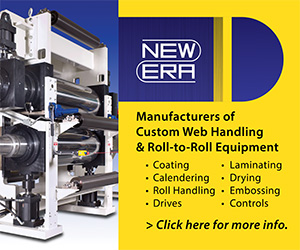Porous Substrates
- Published: February 26, 2015
If you'd like to hear from Mark Miller's own lips rather than read his blog, titled "Porous Substrates," click on his podcast below:
{mp3}porous-substrates-voice{/mp3}
Nonwovens, fabrics, papers and membranes provide unique substrates for fluid coating applications. Depending on the final product needs, the fluid may need to be placed on top of the substrate, penetrate all the way through the substrate or some arrangement of the fluid between these two extremes. So what can you do to control fluid flow once the liquid is placed on the substrate? The keys lie in coating technique and understanding the wetting behavior of the fluid.
When coating porous substrates, many techniques can be considered, but the fluid flow after coating needs to be studied for proper technique choice. Tensioned web coating, where the substrate is tensioned over the coating head, would allow for the most penetration without a backing roll to collect extraneous liquid. Direct coating may be a reasonable choice for full penetration of liquid into the substrate because of the narrow gaps and higher pressures experienced at the coating bead, but you need to be aware of fluid deposition onto the backing roll. Indirect coating (kiss coating), where the liquid is coated onto a reverse roll applicator, would allow for the liquid to be placed on the substrate with minimal contact footprint. This minimal contact footprint can have it’s own gap based off capillary and hydrodynamic forces. Curtain coating has historically been utilized for irregular surfaces and can be considered for porous substrates at higher speeds. With all coating techniques, the pore size and capillary interaction between the fluid and the substrate needs to be considered.
Whatever coating technique is utilized remember that the fluid is displacing air at the fluid substrate interface. This is further complicated by the fact that air can travel through the substrate. This phenomena needs to be heavily weighted in the setup and operation of the coating equipment. Air is evil. We constantly work on eliminating air in the fluid and air encapsulation at the liquid-solid interface. But when the solid is porous air can be introduced from the backside.
Flow hydrodynamics after the fluid is placed on or into a porous substrate depends on the surface tension and surface energy in addition to the capillary action of the fluid substrate interaction and the pore size and shape for the substrate. Rheology and morphology therefore play an important role in understanding fluid flow after placement. To visualize fluid flow, rheological analysis and microscopy can provide a better understanding.
With rheological analysis we can get an idea of whether viscous behavior controls or elastic behavior controls. If viscous behavior controls, then capillary action of the fluid may dominate the fluid path into the substrate. If elastic behavior dominates, a bridge may form over pores allowing the fluid to straddle the substrate gaps and sit more on top of the substrate without being pulled in further. This rheological nature can also be further controlled with solids content. Where more solvent would allow for further penetration and less solvent would allow for shorter oven length for drying in addition to less penetration. Sometimes fillers can be added that can provide the same benefit of lower penetration if simply increasing solids is not an option.
Morphology, or the physical shape of the substrate, also plays a role. Flatter porous substrates present more surface area to allow for more immediate capillary action while rougher porous substrates provide more time before capillary action takes place. The substrate morphology in addition to the liquid-solid characteristics of the fluid can provide overlapping lattices that can suspend a liquid long enough to allow the curing to lock in the coating prior to considerable flow into pores. Also, fiber swell at the liquid-solid interface may adjust liquid pick-up and coat-ability.
Regardless of coating technique, rheology or morphology, surface treatment is always an option to consider. Controlling the surface energy and tension of the respective substrate and fluid can allow for the fluid to sit on the substrate more than sink. Depending on the substrates and fluids considered, treatments may vary. Of the forces that control fluid flow into the substrate, pressure is most important and capillary action secondary. Consider reducing pressure flow with coating technique and capillary action with chemistry and morphology.
Finally, in addition to the interfacial interaction between liquid and substrate, one should also consider the compressibility of the substrate. How the substrate deforms (especially in close proximity coating techniques) can lead to a varied morphology or pressurized fluid flow unexpected when studying the raw materials.
With all these items in mind – rheology, morphology, capillary action, pressurized fluid flow, surface treatment, substrate compressibility and coating technique, there is a lot to consider when coating a porous substrate. However, you now are armed with the necessary tools to investigate, solve and produce porous substrate products. Happy coating!







